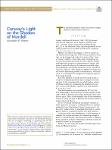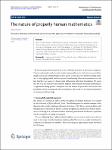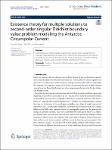Search
Author
- Carlos, Alegría (2)
- Carlos, Seara (2)
- David, Orden (2)
- Klaus, Bretterbauer (2)
- next >
Subject
Date issued
Has File(s)
- true (287)
Search Results
Markov introduced his triples in 1879 in relation to the Diophantine properties of the binary quadratic forms that can be interpreted as the description of the “most irrational” numbers. Since then, many surprising connections have been discovered between Markov triples and hyperbolic geometry, combinatorics of words, and, more recently, the theory of Frobenius manifolds, algebraic geometry, and cluster mutations (see [1, 2] and the references therein). This makes the Markovian theme one of the most fascinating stories in mathematics, which because of a still unproven uniqueness conjecture [1] is far from being finished. |
We claim that human mathematics is only a limited part of the consequences of the chosen basic axioms. Properly human mathematics varies with time but appears to have universal features which we try to analyse. In particular, the functioning of the human brain privileges concept naming and short formulations. This leads to organising mathematical knowledge structurally. We consider briefly the problem of non-mathematical sciences. |
We study singular perturbations of eigenvalues of the polyharmonic operator on bounded domains under removal of small interior compact sets. We consider both homogeneous Dirichlet and Navier conditions on the external boundary, while we impose homogeneous Dirichlet conditions on the boundary of the removed set. To this aim, we develop a notion of capacity which is suitable for our higher-order context, and which permits to obtain a description of the asymptotic behaviour of perturbed simple eigenvalues in terms of a capacity of the removed set, in dependence of the respective normalized eigenfunction. |
The paper investigates stability properties of solutions of optimal control problems constrained by semilinear parabolic partial differential equations. Hölder or Lipschitz dependence of the optimal solution on perturbations are obtained for problems in which the equation and the objective functional are affine with respect to the control. The perturbations may appear in both the equation and in the objective functional and may nonlinearly depend on the state and control variables. |
Given input–output pairs of an elliptic partial differential equation (PDE) in three dimensions, we derive the first theoretically rigorous scheme for learning the associated Green’s function G. By exploiting the hierarchical low-rank structure of G, we show that one can construct an approximant to G that converges almost surely and achieves a relative error of O(Γ−1/2ϵlog3(1/ϵ)ϵ) using at most O(ϵ−6log4(1/ϵ)) input–output training pairs with high probability, for any 0<ϵ<1. The quantity 0<Γϵ≤1 characterizes the quality of the training dataset. Along the way, we extend the randomized singular value decomposition algorithm for learning matrices to Hilbert–Schmidt operators and characterize the quality of covariance kernels for PDE learning. |
In the article, we present multiple solutions for a second-order singular Dirichlet boundary value problem that arises when modeling the ocean flow of the Antarctic Circumpolar Current. The main tools of the proof are the Leray–Schauder nonlinear alternative principle and a well-known fixed point theorem in cones. |
In this paper, blow-up solutions of autonomous ordinary differential equations (ODEs) which are unstable under perturbations of initial points, referred to as saddle-type blow-up solutions, are studied. Combining dynamical systems machinery (e.g., compactifications, timescale desingularizations of vector fields) with tools from computer-assisted proofs (e.g., rigorous integrators, the parameterization method for invariant manifolds), these blow-up solutions are obtained as trajectories on local stable manifolds of hyperbolic saddle equilibria at infinity. With the help of computer-assisted proofs, global trajectories on stable manifolds, inducing blow-up solutions, provide a global picture organized by global-in-time solutions and blow-up solutions simultaneously. |
We introduce Neural Network (NN for short) approximation architectures for the numerical solution of Boundary Integral Equations (BIEs for short). We exemplify the proposed NN approach for the boundary reduction of the potential problem in two spatial dimensions. We adopt a Galerkin formulation-based method, in polygonal domains with a finite number of straight sides. Trial spaces used in the Galerkin discretization of the BIEs are built by using NNs that, in turn, employ the so-called Rectified Linear Units (ReLU) as the underlying activation function. The ReLU-NNs used to approximate the solutions to the BIEs depend nonlinearly on the parameters characterizing the NNs themselves. |
Derivatives with respect to the parameters of the integral Mittag-Leffler function and the integral Wright function, recently introduced by us, are calculated. These derivatives can be expressed in the form of infinite sums of quotients of the digamma and gamma functions. In some particular cases, these infinite sums are calculated in closed-form with the help of MATHEMATICA. However, parameter differentiation reduction formulas are explicitly derived in order to check some of the results given by MATHEMATICA, as well as to provide many other new results. |
A new Levenberg–Marquardt (LM) method for solving nonlinear least squares problems with convex constraints is described. Various versions of the LM method have been proposed, their main differences being in the choice of a damping parameter. In this paper, we propose a new rule for updating the parameter so as to achieve both global and local convergence even under the presence of a convex constraint set. The key to our results is a new perspective of the LM method from majorization-minimization methods. Specifically, we show that if the damping parameter is set in a specific way, the objective function of the standard subproblem in LM methods becomes an upper bound on the original objective function under certain standard assumptions. Our method solves a sequence of the subproblems... |










